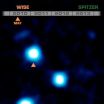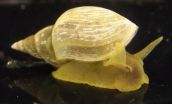(Press-News.org) A "brown dwarf" star that appears to be the coldest of its kind -- as frosty as Earth's North Pole -- has been discovered by a Penn State University astronomer using NASA's Wide-field Infrared Survey Explorer (WISE) and Spitzer Space Telescopes. Images from the space telescopes also pinpointed the object's distance at 7.2 light-years away, making it the fourth closest system to our Sun.
"It is very exciting to discover a new neighbor of our solar system that is so close," said Kevin Luhman, an associate professor of astronomy and astrophysics at Penn State and a researcher in the Penn State Center for Exoplanets and Habitable Worlds. "In addition, its extreme temperature should tell us a lot about the atmospheres of planets, which often have similarly cold temperatures."
Brown dwarfs start their lives like stars, as collapsing balls of gas, but they lack the mass to burn nuclear fuel and radiate starlight. The newfound coldest brown dwarf, named WISE J085510.83-071442.5, has a chilly temperature between minus 54 and 9 degrees Fahrenheit (minus 48 to minus 13 degrees Celsius). Previous record holders for coldest brown dwarfs, also found by WISE and Spitzer, were about room temperature.
Although it is very close to our solar system, WISE J085510.83-071442.5 is not an appealing destination for human space travel in the distant future. "Any planets that might orbit it would be much too cold to support life as we know it" Luhman said.
"This object appeared to move really fast in the WISE data," said Luhman. "That told us it was something special." The closer a body, the more it appears to move in images taken months apart. Airplanes are a good example of this effect: a closer, low-flying plane will appear to fly overhead more rapidly than a high-flying one.
WISE was able to spot the rare object because it surveyed the entire sky twice in infrared light, observing some areas up to three times. Cool objects like brown dwarfs can be invisible when viewed by visible-light telescopes, but their thermal glow -- even if feeble -- stands out in infrared light.
After noticing the fast motion of WISE J085510.83-071442.5 in March, 2013, Luhman spent time analyzing additional images taken with Spitzer and the Gemini South telescope on Cerro Pachon in Chile. Spitzer's infrared observations helped to determine the frosty temperature of the brown dwarf.
WISE J085510.83-071442.5 is estimated to be 3 to 10 times the mass of Jupiter. With such a low mass, it could be a gas giant similar to Jupiter that was ejected from its star system. But scientists estimate it is probably a brown dwarf rather than a planet since brown dwarfs are known to be fairly common. If so, it is one of the least massive brown dwarfs known.
Combined detections from WISE and Spitzer, taken from different positions around the Sun, enabled the measurement of its distance through the parallax effect. This is the same principle that explains why your finger, when held out right in front of you, appears to jump from side to side when you alternate left-eye and right-eye views.
In March of 2013, Luhman's analysis of the images from WISE uncovered a pair of much warmer brown dwarfs at a distance of 6.5 light years, making that system the third closest to the Sun. His search for rapidly moving bodies also demonstrated that the outer solar system probably does not contain a large, undiscovered planet, which has been referred to as "Planet X" or "Nemesis."
"It is remarkable that even after many decades of studying the sky, we still do not have a complete inventory of the Sun's nearest neighbors," said Michael Werner, the project scientist for Spitzer at NASA's Jet Propulsion Laboratory (JPL), which manages and operates Spitzer. "This exciting new result demonstrates the power of exploring the universe using new tools, such as the infrared eyes of WISE and Spitzer."
INFORMATION:
[ Whitney Clavin / B K K ]
CONTACTS
Kevin Luhman: kluhman@astro.psu.edu, (+1) 814-863-4957 or (+1) 814-865-0418
Barbara Kennedy (PIO): science@psu.edu, 814-863-4682
ANIMATION AND IMAGES
An animation and high-resolution images are online at science.psu.edu/news-and-events/2014-news/Luhman4-2014
Star is discovered to be a close neighbor of the Sun and the coldest of its kind
2014-04-25
ELSE PRESS RELEASES FROM THIS DATE:
New genome-editing platform significantly increases accuracy of CRISPR-based systems
2014-04-25
A next-generation genome editing system developed by Massachusetts General Hospital (MGH) investigators substantially decreases the risk of producing unwanted, off-target gene mutations. In a paper receiving online publication in Nature Biotechnology, the researchers report a new CRISPR-based RNA-guided nuclease technology that uses two guide RNAs, significantly reducing the chance of cutting through DNA strands at mismatched sites.
"This system combines the ease of use of the widely adopted CRISPR/Cas system with a dimerization-dependent nuclease activity that confers ...
Scientists at the UA make critical end-stage liver disease discovery
2014-04-25
A team of researchers in the University of Arizona's College of Pharmacy has discovered a molecular pathway that could be key to creating new therapeutics that would slow or even reverse the progression of end-stage liver disease.
Although cirrhosis of the liver is most commonly associated with alcohol or drug abuse, the condition – marked by scar tissue replacing healthy liver tissue – also can result from viral hepatitis, obesity and diabetes, as well as certain inherited diseases. According to the National Institutes of Health, cirrhosis is the 12th leading cause of ...
Biologists discover a key regulator in the pacemakers of our brain and heart
2014-04-25
Biologists have discovered how an outer shield over T-type channels change the electrochemical signaling of heart and brain cells. Understanding how these shields work will help researchers eventually develop a new class of drugs for treating epilepsy, cardiovascular disease and cancer.
The study from the University of Waterloo is published in the Journal of Biological Chemistry today and is featured as the "Paper of the Week" for its significance.
The researchers discovered T-type channels in the pond snail, Lymnaea stagnalis, can shift from using calcium ions to ...
Study finds almost half of homeless men had traumatic brain injury in their life
2014-04-25
TORONTO, April 25, 2014—Almost half of all homeless men who took part in a study by St. Michael's Hospital had suffered at least one traumatic brain injury in their life and 87 per cent of those injuries occurred before the men lost their homes.
While assaults were a major cause of those traumatic brain injuries, or TBIs, (60 per cent) many were caused by potentially non-violent mechanisms such as sports and recreation (44 per cent) and motor vehicle collisions and falls (42 per cent).
The study, led by Dr. Jane Topolovec-Vranic, a clinical researcher in the hospital's ...
Genome regions once mislabeled 'junk' linked to heart failure
2014-04-25
Large sections of the genome that were once referred to as "junk" DNA have been linked to human heart failure, according to research from Washington University School of Medicine in St. Louis.
So-called junk DNA was long thought to have no important role in heredity or disease because it doesn't code for proteins. But emerging research in recent years has revealed that many of these sections of the genome produce RNA molecules that, despite not being proteins, still have important functions in the body. RNA is a close chemical cousin to DNA.
Molecules now associated ...
'Beneficial inflammation' may promote healing in pulmonary fibrosis
2014-04-25
Inflammation has long been considered an integral part of the biological process that leads to deadly scarring in idiopathic pulmonary fibrosis. New research at National Jewish Health, however, suggests that a little inflammation may also be crucial to the healing and repair processes in the lungs. Elizabeth Redente, PhD, assistant professor of cell biology at National Jewish Health, and her colleagues report in the April 2014 issue of the American Journal of Respiratory Cell and Molecular Biology that the pro-inflammatory cytokine TNF-α can speed recovery of injured ...
Buzz and Bite Highlighted In New Malaria Museum
2014-04-25
Chocolate Moose Media's Buzz and Bite public service announcements (PSA) have had a profound effect combatting the spread of malaria around the world. Now the series will be featured in a new museum in Dublin, Ireland, dedicated to malaria.
Buzz and Bite comprises 30 animated spots of either 30 or 60 seconds that feature two female anopheles (malaria-carrying) mosquitos. Creator and company president Firdaus Kharas uses humour as the two winged characters try to infect every human on the planet. The series teaches about the value of insecticide-treated sleeping nets ...
Revolutionary 'metamaterial' has potential to reshape neurosurgery
2014-04-25
Philadelphia, Pa. (April 25, 2014) – The development of graphene—a highly advanced metamaterial with many unique and varied properties—may lead to exciting new applications in the diagnosis and treatment of neurological diseases, according to a report in the May issue of Neurosurgery, official journal of the Congress of Neurological Surgeons. The journal is published by Lippincott Williams & Wilkins, a part of Wolters Kluwer Health.
Tobias A. Mattei, MD, of Invision Health/Brain & Spine Center – Buffalo, New York and Azeem A. Rehman, BS, of The University of Illinois ...
It's not all wedded bliss: Marital stress linked to depression
2014-04-25
MADISON, Wis. – Marital stress may make people more vulnerable to depression, according to a recent study by University of Wisconsin-Madison researchers and their colleagues.
The long-term study, published in the April 2014 Journal of Psychophysiology, shows that people who experience chronic marital stress are less able to savor positive experiences, a hallmark of depression. They are also more likely to report other depressive symptoms.
The findings are important, says study leader Richard Davidson, UW-Madison William James and Vilas Professor of Psychology and Psychiatry, ...
Fires in the Yucatan Peninsula in April 2014
2014-04-25
April is in the middle of the dry season, which runs from January through May in this region, and naturally coincides with fire season. Farmers often use fire to return nutrients to the soil and to clear the ground of unwanted plants. Fire helps enhance crops and grasses for pasture. Some of the fires in this image may be wildfires, with natural (lightning) or accidental (human) sources. As the dry season progresses, the number of fires tend to grow, as does the blanket of smoke which settles over the land, and although the fire may help the farmers get their lands ready ...







